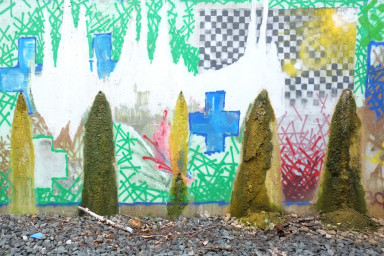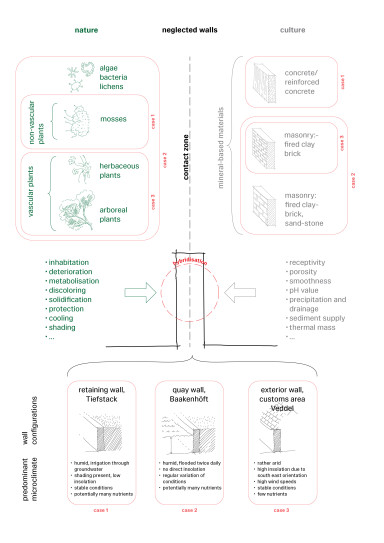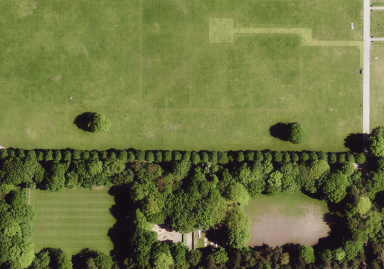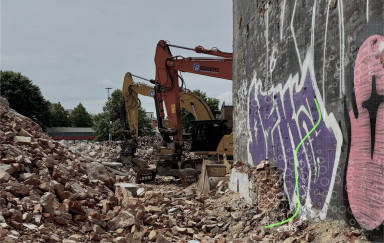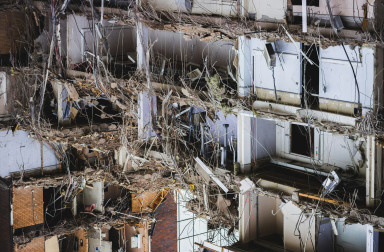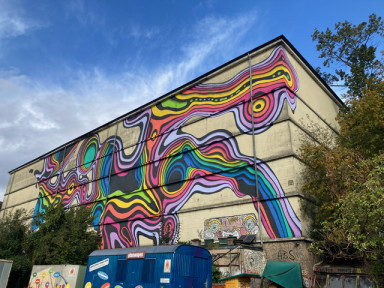Neglected walls
Contact zones of architectural matter and spontaneous vegetation
In the face of escalating environmental degradation and the biodiversity crisis, this doctoral research investigates neglected urban walls as potential ‘contact zones’1 between architectural matter and spontaneously emerging vegetation. Building on Georg Simmel’s conception of ruins as manifestations of the intertwined dialectical relationship between human intention and natural forces,2 the project situates contemporary ruins – specifically focusing on neglected walls – within the broader discourse of posthuman architecture. At a time when cities are increasingly conceived as habitats for multiple species, the role of architecture in either exacerbating or mitigating ecological crises demands urgent re-evaluation. Ruins, and particularly their vertical surfaces, provide a unique opportunity to observe how nonhuman life – plants, fungi, and microbes – appropriates and transforms human-made matter. In this context, walls become sites of spontaneous biotic–abiotic entanglements and localized ecological activity. The research focuses on three neglected wall surfaces in Hamburg, adopting a multimodal, transdisciplinary approach that combines an array of graphic methods of inquiry, theoretical analysis, and design experimentation, to develop constructive and aesthetic principles that support and extend existing processes of biotic inhabitation – promoting an architectural practice that moves beyond anthropocentric paradigms and instead cultivates collaboratively shaped environments in response to interwoven ecological crises.
- neglected walls as sites of biotic–abiotic interaction
- spontaneous vegetation
- biodiversity support
- non-human agency
Context
In focusing on neglected urban walls as hybrid artefacts – assemblages of mineral-based building materials and spontaneously emerging microbial life and vegetation – this research adopts a transdisciplinary approach. Urban ecology shows that walls as habitats can potentially host highly specific plant communities akin to those in severe environments such as cliffs or mountains.3 While a large body of research on mediaeval masonry structures as habitat exists, research on walls constructed within the last two centuries remains limited. Building material science reveals how properties such as porosity and chemical composition shape bioreceptivity4 of mineral-based materials, while biodeterioration5 research addresses physical and chemical impacts of biotic growth. This project reframes plant–material interaction, traditionally framed as a threat, as a design opportunity and investigates how walls can support multispecies cohabitation without compromising structural integrity. Situated within contemporary architectural discourse on more-than-human design, the work diverges from studies of engineered green façades by instead focusing on spontaneous growth in the existing urban fabric. Bridging architecture, urban ecology, and material science, the study seeks to develop strategies that integrate natural processes into urban planning and architecture, contributing to sustainable and multispecies futures.
Aims
By reconceptualizing neglected walls not as remnants of decay but as generative sites of resilience and ecological development, this project aims to contribute to current academic discourses in the field of architectural theory. The subsequent proposition of new models for the integration of a natural succession of ecosystems into wall surfaces impacts architectural practice in the light of demand for more ecologically just urban futures.
Guiding research-questions are:
How do the properties and capacities of building materials, plant and microbial species, and environmental conditions generate spontaneous interactions on neglected walls in Hamburg?
In what ways can spontaneously emerging material interactions between architecture, vegetation, and environmental forces be actively fostered and stabilized?
How can the observed interactions inform the development of new design strategies and how do these strategies resonate with current theoretical debates in the context of ecological crisis?
Research design
Three neglected wall surfaces within Hamburg are documented thoroughly, adopting a multimodal, transdisciplinary approach that combines site-specific observation, cartographic documentation, and theoretical analysis. This documentation will inform three careful, site-specific interventions that experimentally examine how architectural practice might move beyond anthropocentric paradigms and instead cultivate collaboratively shaped environments in response to interwoven ecological crises. Drawing on current debates in architectural theory, reflection on the study’s empirical findings and interventions will inform the development of materially grounded design strategies that are attentive to spontaneous inhabitation and help to counteract situated ecological crises.
Supervisors:
